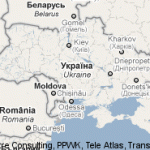Cyrillic: confusion
 My latest travels have brought me to Ukraine, an eastern European republic with a rich cultural history – though in recent years it is too often only recognized for the Chernobyl disaster in 1986.
My latest travels have brought me to Ukraine, an eastern European republic with a rich cultural history – though in recent years it is too often only recognized for the Chernobyl disaster in 1986.
Whilst I have been here, I have attempted to learn some Ukrainian in order to get by. This has of course involved learning the Cyrillic alphabet, which dates back to around the 9th century. There are elements of the Greek alphabet in there, which has helped me – letters such as ф (еф) for the f sound (identical to the Greek phi), п (пе) for p (or Greek pi), and р (ер) for r (or Greek rho).
This also helps with letters that are the same in the Greek alphabet as they are in our Roman alphabet – a, e, i, o, k, m and t all perform pretty much the same function in Ukrainian and Russian as they do in English.
However, it’s taking time for me to learn to read billboards and shop signs with any kind of fluency – not due to the letters whose forms are completely new to me such as д for d, and ц for ts; but due to the letters that I do recognise but are sounded entirely differently in Ukrainian.
For example, the с (ес) is pronounced like an English s, and an н (ен) is an n sound. This creates a lot of confusion and second guessing on my part.
So, the word for “alphabet” comes out as алфаві́т – not so tough. But the word for “Ukraine” is written Україна (Ukrayina), but my brain wants to say something like “ykraiha”, which is nothing like what it should be!
Still – like anything else, I’m sure that I can get the hang of it if I practice, practice, practice.
